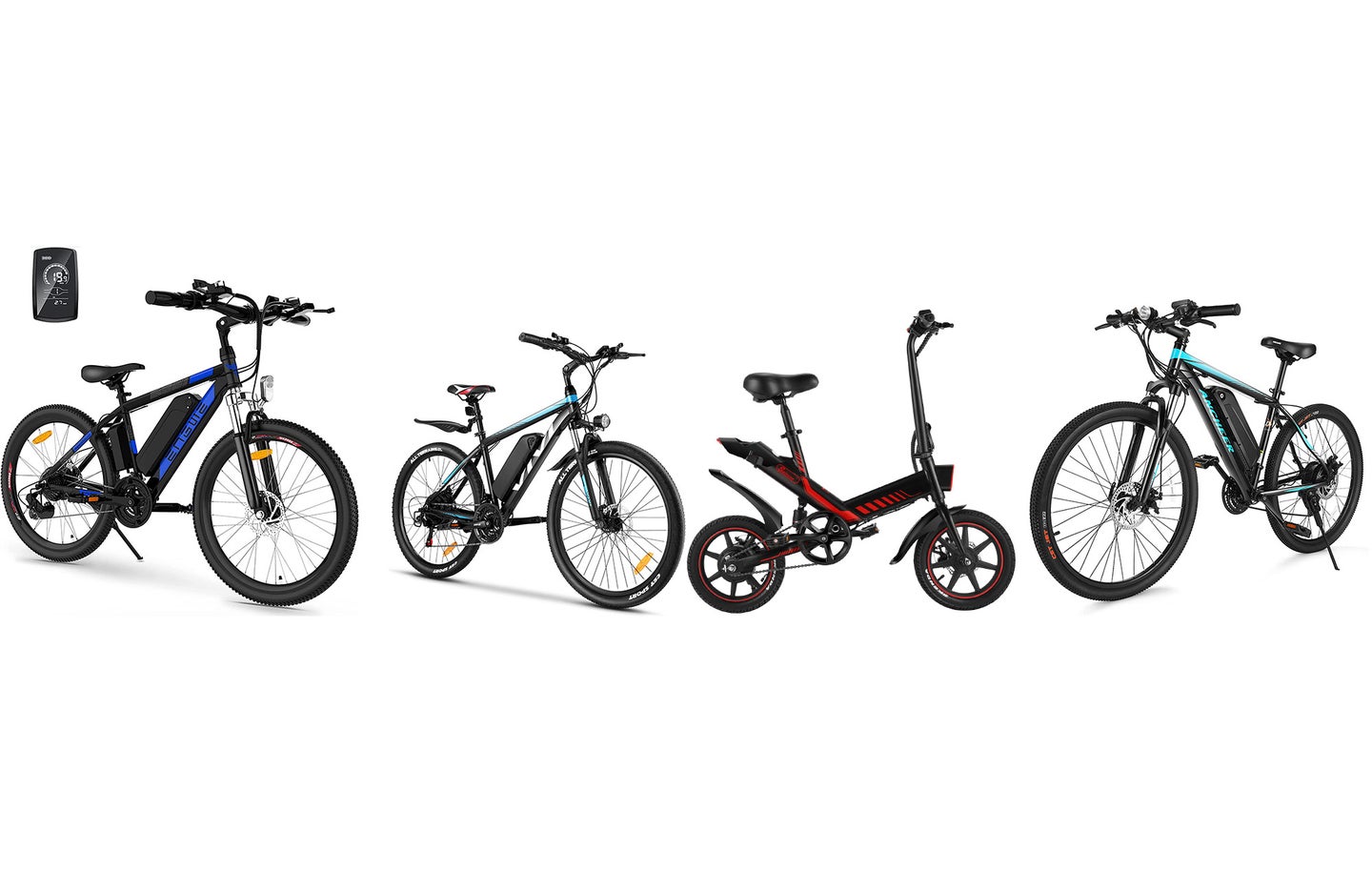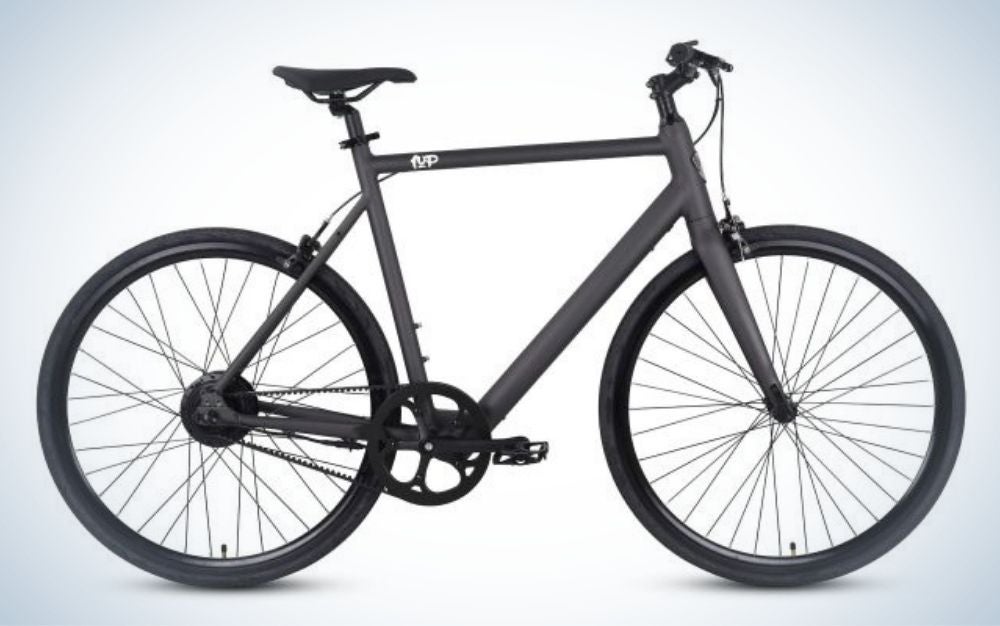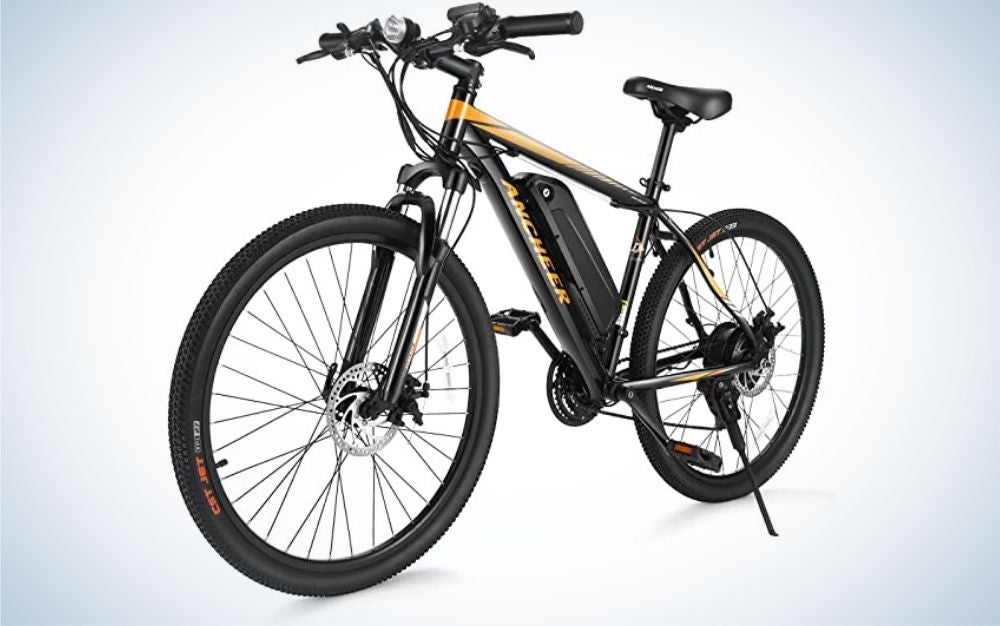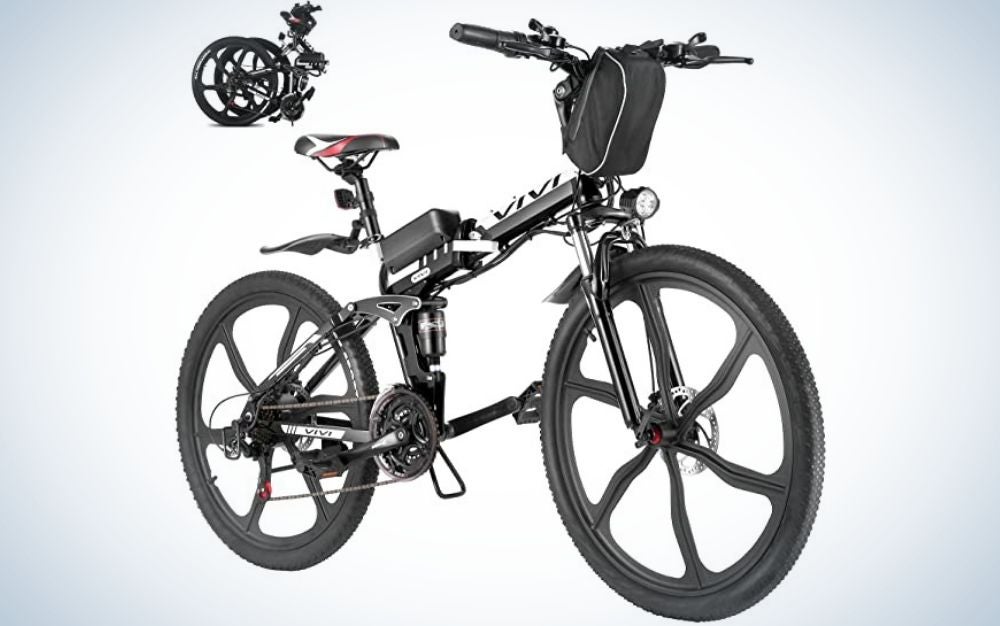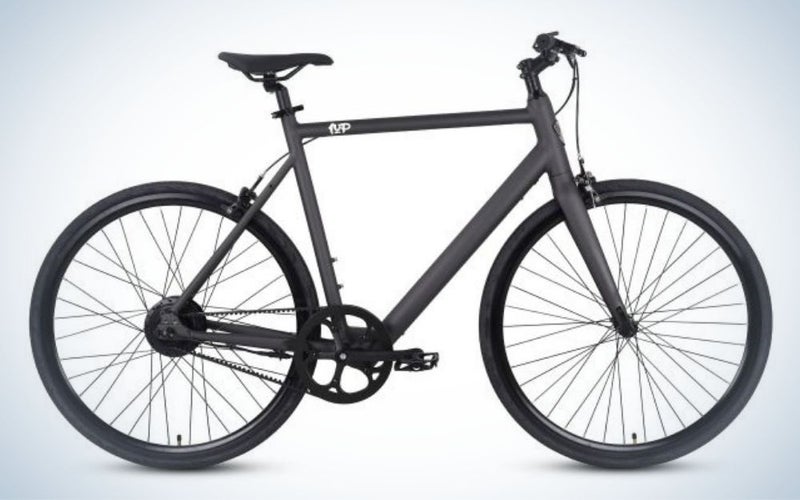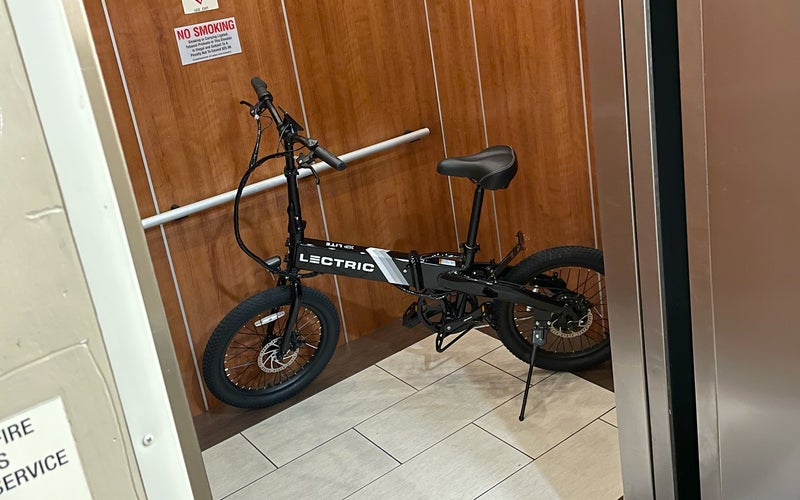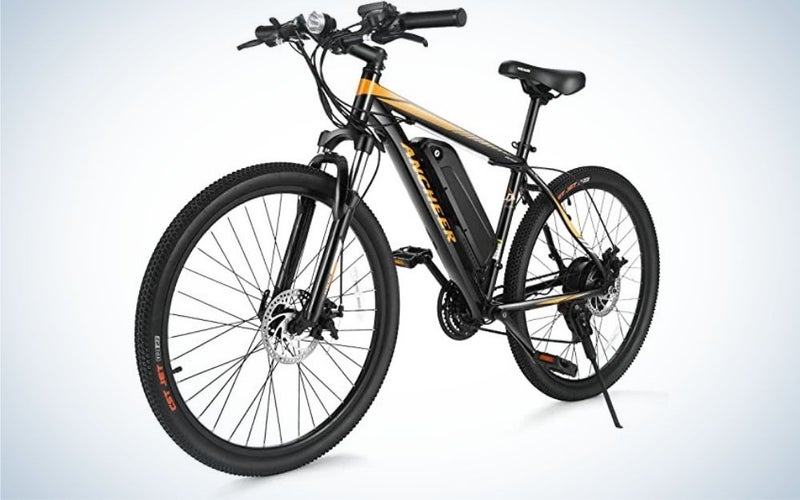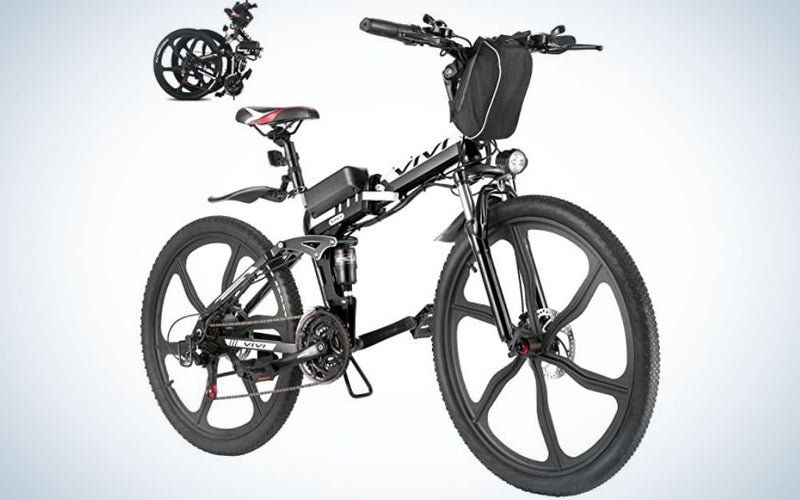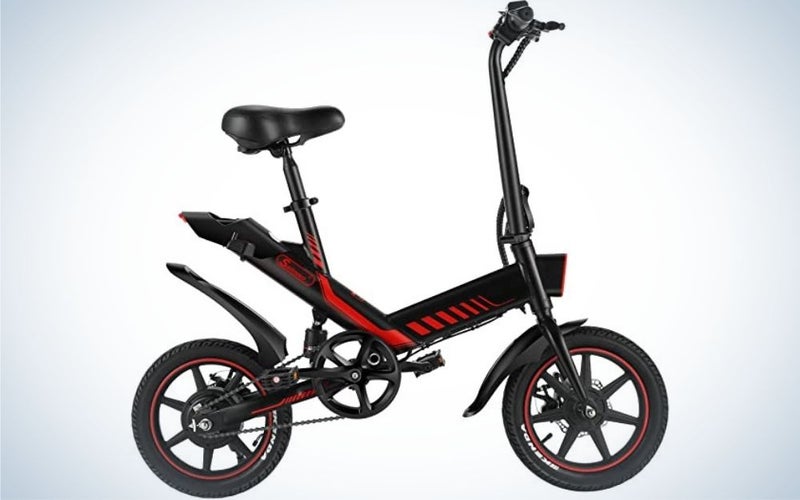We may earn revenue from the products available on this page and participate in affiliate programs. Learn more ›
Is the term budget electric bike an oxymoron? Two things are certain about ebikes: They’re really cool, and they are very expensive. They often cost upwards of $2,000, so getting one is no small investment. There are plenty of people who can’t afford one. That said, it is possible to get a decent ebike for less than $1,000. A few brands have designed relatively affordable ebikes that deliver admirable functionality at the low end of the price range. They tend to be foldable or compact versions for commuters, so they’re made for relatively light use, but there are options for trail bikers, too. Let’s examine the benefits and limitations of the best budget electric bikes.
- Best overall: Ride1Up Roadster V2
- Best for urban adventures (and apartments): Lectric Bikes XP Lite
- Best mountain: Ancheer Electric Mountain Bike 350W 26”
- Best folding: Vivi 26-inch Folding Electric Mountain Bike
- Best compact: Sailnovo 14” Electric Bike
How we chose the best budget electric bikes
I’ve been an avid outdoorsman enthusiast for my entire life, which has resulted in several years of providing gear and tech coverage for outlets like Popular Science, the Daily Beast, Runner’s World, Thrillist, the Manual, and more. My love of cycling has been a recurring theme throughout all of it.
Over the past several months, I’ve ridden dozens of electric bikes at all different price points and categories. I have come to learn what to look for when separating genuine quality from flashy marketing. In certain cases, those tests were supplemented with research collating reviews from experts and impressions from customers alike.
The best budget electric bikes: Reviews & Recommendations
The best budget ebikes span several different riding purposes and considerations. While most low-cost ebikes are often very similar, our picks offer distinctive riding experiences. They got our attention; maybe you’ll see something in them, too.
Best overall: Ride1Up Roadster V2
ride1up
Buy it used or refurbished: eBay
Why it made the cut: The Ride1Up Roadster V2 is an all-around great ebike that won’t break the bank.
Specs
- Battery capacity: 36V 7Ah (252Wh)
- Range: Approximately 12-20 miles (and maybe even more)
- Motor: 350W (500W peak)
Pros
- Solid all-purpose bike
- Relatively good range and power
- Classic looks
- Smooth ride
Cons
- Not for short riders
- No lights
For just $1,000, the Ride1up Roadster V2 is a remarkably well-rounded and polished bike. High-powered for its price with a 350W motor, the Roadster V2 provides strong acceleration and propulsion, making it capable of reaching 24 miles per hour with pedal assist. It also has a range of 12-20 miles on average, with several riders suggesting they’ve gone 25 miles on a single charge. That’s a great range for an around-town cruiser.
It’s lightweight—only 33 pounds—and durably built. Plus, it looks very slick, with a classic aesthetic that almost doesn’t look like an ebike.
The Roadster V2 isn’t perfect, though. It’s a very tall bike, best suited for riders 5’8” and over. It also doesn’t have much in the way of accessories; there’s not even a headlight, which is pretty standard at this point.
Still, with all the core features working at or above our expectations, you’ll be hard-pressed to find an ebike that works so well for this price.
Best for urban adventures (and apartments): Lectric Bikes XP Lite
Tony Ware
Why it made the cut: Small but spry, the Lectric Bikes XP Lite lets you zip through crowds and doesn’t require much storage space.
Specs
- Battery capacity: 48V 7.8 Ah (374 Wh)
- Range: 15-40 miles
- Motor: 300W nominal, 720W peak
Pros
- Good range and power
- Solid build quality
- Class 1 or 2
Cons
- Lack of suspension is noticeable on rough roads
Started in 2019 from a garage in Phoenix, Ariz., Lectric Bikes expanded quickly because of the company’s restless spirit. Not only are the company’s ebikes intended for the intrepid—for gaining the experience points, XP, in the bike names—but the founders are continually listening to user feedback to refine the product line while maintaining affordability.
Foldable yet offroad-friendly, the core Lectric XP 3.0 model can comfortably accompany RVers and van-lifers. The less-expensive XP Lite, meanwhile, was developed as the optimal option for city dwellers needing a lighter-weight ebike that could go from closet to commute. It even shows up quickly in a surprisingly compact box. At 46 pounds, and 36- x 16- x 26-inch folded dimensions, the XP Lite is easy to tuck and transport via elevator, as shown above—or even stairs in a pinch, as shown below—while packing in a lot of features for its $799 price point.
Class 1 and 2, the XP Lite features a twist-grip throttle plus five levels of pedal assist, with slimmer tires that assist the maneuverability needed in active urban environments. The 48V lithium-ion battery can get up to 40 miles on a charge (assuming you’re using no more than intermittent pedal assist level 1). Or you can use the throttle to scoot to/from work, the store, etc., quickly with the least effort and sweat (the single-speed drivetrain makes it easy—just twist and go—but you’ll get max 15 miles in this mode).
The base XL Lite includes front & rear safety lights, and a backlit heads-up LCD screen offers trip and battery info (electrical components are IP65-rated in case you get caught in incremental weather, but don’t leave the bike out in the rain). You’ll absorb some shocks if navigating uneven asphalt, and acceleration—while appropriately fast for street navigation—isn’t always the smoothest in transition. But you can buy an optional seat with a suspension post, and you’ll appreciate the nimble nature of the bike whether you’re zipping through downtown or kicking up some dust on more developed trails. — Tony Ware

Best mountain bike: Ancheer Electric Mountain Bike 350W 26”
ANCHEER
Why it made the cut: Most electric mountain bikes cost thousands of dollars. This one’s highly capable and costs less than $700.
Specs
- Battery capacity: 36V 10.4Ah (374.4Wh)
- Range: 20+ miles
- Motor: 350W
Pros
- Good range and power
- Solid build quality
- Shock-absorbing fork
- 21-speed shifter w/ throttle
Cons
- No built-in light
- Poor customer service from the manufacturer
It’s not uncommon for electric mountain bike prices to steer closer toward $10,000 than $1,000, making them a very hard sell. Luckily, Ancheer makes a highly capable alternative that costs less than $700.
With a 350W motor capable of cruising at 20 miles per hour, the Ancheer Electric Mountain Bike has no problem charging up inclines. It also has a substantial range, with many users reporting that it will go well over 20 miles if you’re using the throttle economically.
Its design is also surprisingly solid for a budget electric mountain bike, inspiring several buyers to leave shining reviews after several months of hitting the trails. Shock absorbers in the fork deliver a smooth, capable riding experience. And its overall aesthetic is clean and sporty.
Best folding: Vivi 26-inch Folding Electric Mountain Bike
Vivi
Buy it used or refurbished: eBay
Why it made the cut: The Vivi 26-inch Folding Electric Mountain Bike feels especially solid for a folding ebike.
Specs
- Battery capacity: 36V 8Ah (288Wh)
- Range: Approximately 14 miles
- Motor: 350W
Pros
- Solid all-purpose bike
- Relatively good range and power
- Shock absorbers
- 21-speed shifter w/ throttle
Cons
- Slow charging
- Poor customer service from the manufacturer
Most folding electric bikes feel somewhat rickety, thanks to their signature hinges. Budget bike-maker Vivi somehow made a folding design that minimizes that wiggle in its 26-inch Electric Mountain Bike, and does so without charging an arm and a leg.
Its strong 350W motor will zip you up to 20 miles per hour using either throttle or pedal assist. Its 14-mile range can’t compete with high-level ebikes, but is acceptable for an $800 bike and should be more than enough for local commuters to ride their daily route on a single charge. What’s more, its Shimano 21-speed transmission makes taking on hills effortless.
When you’re done for the day, folding the bike up to store is easy, as is reassembling it to ride. More importantly, the bike feels sturdy despite the movable points on the frame and provides a comfortable riding experience. And it has a built-in headlight that can be switched on via the handlebar control pad, which is also used to shift between three riding modes: normal bike mode, pedal-assist, and pure electric power.
While Vivi has a solid bike on its hands here, the company has earned a reputation for poor customer service when issues have cropped up. This may impact the bike’s long-term viability, but it is also a common issue with companies targeting budget products.
Best compact: Sailnovo 14-Inch Electric Bike
Sailnovo
Buy it used or refurbished: eBay
Why it made the cut: The Salinovo 14-inch Electric Bike offers supreme portability and solid performance.
Specs
- Battery capacity: 36V 10.4Ah (374.4Wh)
- Range: Approximately 18 miles
- Motor: 450W
Pros
- Strong motor
- Relatively good range
- Waterproof
- Throttle and pedal assist
Cons
- Could be more ergonomic
- Some customers have had customer service issues
The Salinovo 14-inch Electric Bike is surprisingly powerful for a compact electric bike. Its 450W motor can quickly reach just shy of 20 miles per hour via either the throttle or pedal assist. (Salinovo claims the range goes much further, but some reviewers reported that it falls short of those claims.) Round that out with a surprisingly solid range and little flourishes like integrated head and tail lights, plus a central shock absorber, and you’ve got a pretty solid bike for around $500 bucks.
Some serious cyclists might find that compact, foldable ebikes at these prices don’t deliver the structural solidity they expect from a bike. Generally, they can feel a bit more rickety than their non-folding counterparts. With a bike like the Sailnovo, it’s important to remember that you are making a compromise, favoring affordability and portability over feel and stability. All in all, though, it’s a great little commuter or a fun way to explore a neighborhood.
Things to consider before choosing the best budget electric bikes
If you’ve come looking for the best budget electric bikes, rather than simply the best electric bikes, then we know the price is on your mind. Even cheap bikes cost a few hundred dollars, though, so you want to make sure you’re putting that money into something worth riding. There are several specific factors you should keep in mind, so you can figure out whether a budget ebike is a bargain or, for lack of a better word, junk. The best budget electric bikes will deliver in these specific ways.
Price
First and foremost, you’re here because you’re looking for an electric bike that won’t cost as much as a used car—all of the bikes on this list cost under $1,000. We also included a few compact bicycles that cost around $500. These offer somewhat limited functionality and durability compared to full-size ebikes, but they’re still great for the price.
Riding range
An electric bike that runs out of juice after a few miles isn’t worth buying, no matter the price. What good is a motor if it can’t get you from point A to point B? A large battery will ensure you get a boost from your ebike, rather than pushing it home.
Most ebikes rate their batteries in a combination of volts (V) and amp-hours (Ah), which you can combine to calculate a bike battery’s actual capacity in watt-hours (Wh). Watt-hours are the more useful specification, as they allow you to approximate how long the battery will last at a given speed.
Converting volts and amp-hours into watt-hours is easy. Simply multiply the two numbers together. A number of our picks, for example, boast 36V 8Ah batteries. 36 x 8 = 288, so we know that battery lasts for 288Wh. With this number, we can calculate how far the battery will take us by dividing the number of watt-hours by your speed to see how far you’ll go. So, at 20 miles per hour, a 288Wh bike should carry you about 14.5 miles.
“About” is an important word here. In the real world, your actual range will be affected by things like rider weight, road surface, flat vs. hilly terrain, and other factors that can demand more or less power. So, while you can’t measure and determine the minimum amount of juice you’ll need on spec, you can probably figure out if a bike can get you where you need to go.
If nothing else, remember that a bigger battery is always better.
Motor
There’s no point in having an ebike if the motor isn’t powerful enough to take the edge off your pedaling effort. Power is one of the biggest differences between less expensive ebikes and the cream of the crop. Many are so weak that you’ll barely notice the pedal assistance. However, all of the bikes on this list deliver at least 250 watts, meaning they’re capable of delivering solid pedal assistance or even propelling themselves at 20 miles per hour or higher.
Keep in mind that your actual speed will vary based on factors like payload, road conditions, stops and starts, and so on, but a high-watt motor is important, especially when looking to spend less money.
Durability
Whenever you’re going with a budget-tier version of a product, you need to pay extra attention to its overall construction. You aren’t saving money if you buy something cheap, but it breaks down after several uses. To verify the durability of our recommendations, we’ve scoured reviews from owners who can attest to the longevity of each bike.
When you’re checking out a specific bike in the real world, check over its various parts to find out if anything rattles to a worrisome degree. Some budget picks may feel more rickety than their more expensive brethren, but they should still be sturdy and comfortable to ride.
Accessories
Ebikes can come with an extremely wide range of accessories, including lights, bells, cargo carriers, and so on. While you don’t need accessories like these, they can make your riding experience safer, more fun, and more versatile.
FAQs
Q: Are electric bikes worth the money?
Electric bikes are absolutely worth the money for commuters if it allows you to cut down on expenses like gas, parking, and vehicle maintenance. They’re also incredibly fun to ride, especially when they let you blow past traffic jams. That said, they are very expensive, so we’d only recommend them for people who ride a lot. You don’t necessarily need to be a commuter, but they aren’t a worthwhile investment for people who only bike once in a while.
Q: What are the disadvantages of electric bikes?
As we’ve discussed here, money is a major hurdle for most people considering whether or not to buy an ebike. Electric bikes usually cost more than traditional bikes, and they feature more complicated machinery, which translates into more maintenance and repair costs. The range can also be an issue. Electric bikes tend to be very heavy. When they run out of juice, they can be difficult to ride without power assistance.
Q: Do you pedal an electric bike?
You can, but you don’t always need to. On Class 2 and 3 electric bikes with throttles, you can propel the ebike with zero effort. On class 1 bikes with pedal assist, you have to pedal, but the motor speeds you up and does most of the work. Technically, some companies also sell “electric bikes” without pedals. These tend to be cheaper and work similarly to using the throttle on a class 2 or 3 bike. By removing the pedals, these companies are playing with the line between an electric bike and an electric scooter or moped, so we’re not sure they fit what we think of when we talk about ebikes.
Q: How fast do electric bikes go?
Your ebike’s top speed comes down to the motor of its motor, plus several other factors, including rider weight, flat vs. hilly terrain, road surface conditions, bike weight, cargo weight, and so on. They are not so powerful that they can push their limits under any conditions. That said, we generally expect budget ebikes capable of average top speeds between 15-20 miles per hour. A top-of-the-line model should be able to go a bit faster, up to about 28 miles per hour.
Final thoughts on the best budget electric bikes
- Best overall: Ride1Up Roadster V2
- Best for urban adventures (and apartments): Lectric Bikes XP Lite
- Best mountain: Ancheer Electric Mountain Bike 350W 26”
- Best folding: Vivi 26-inch Folding Electric Mountain Bike
- Best compact: Sailnovo 14” Electric Bike
Electric bikes are an environmentally friendly, fun way to get around town, whether commuting, running errands, or simply going for a ride. While they often come with a hefty price tag, there is a price range, and you can get one that won’t cost too much. If $500-$1,000 is still too much, looking for a used or refurbished model may help you cut costs.
Why trust us
Popular Science started writing about technology more than 150 years ago. There was no such thing as “gadget writing” when we published our first issue in 1872, but if there was, our mission to demystify the world of innovation for everyday readers means we would have been all over it. Here in the present, PopSci is fully committed to helping readers navigate the increasingly intimidating array of devices on the market right now.
Our writers and editors have combined decades of experience covering and reviewing consumer electronics. We each have our own obsessive specialties—from high-end audio to video games to cameras and beyond—but when we’re reviewing devices outside of our immediate wheelhouses, we do our best to seek out trustworthy voices and opinions to help guide people to the very best recommendations. We know we don’t know everything, but we’re excited to live through the analysis paralysis that internet shopping can spur so readers don’t have to.
